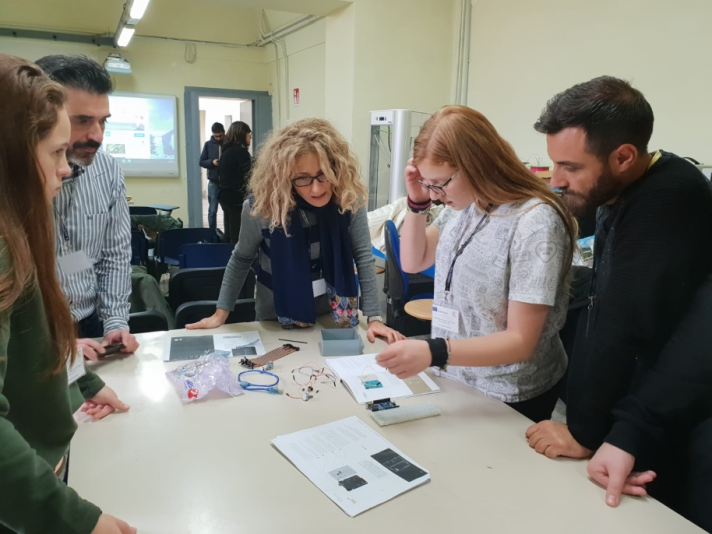Topic(s) addressed
The project aimed to promote the school’s innovative practices with regard to STEAM (Science, Technology, Engineering, Arts, and Mathematics) subjects, and promote gender equity and inclusion in transnational activities by encouraging the participation of female students in science subjects. Topics that were addressed by the project include quality improvement institutions and methods; ICT – new technologies – digital competences; and, gender equality and equal opportunities.
Target groups
The project’s target groups consisted of students between the ages of 14-18 from diverse socioeconomic backgrounds; while Spanish and Romanian students came from rural and isolated areas, Estonian, Turkish, and Italian students came from more populated and better-connected regions. Moreover, of the 10 students who participated in transnational activities in Italy and Romania, 5 of them were female; 33% of the school’s STEAM teachers were trained during the project, with 4 having participated directly in transnational activities.
Methodologies
The project’s implementation was divided into two large blocks: methodology, and project management. Work methodology revolved primarily around similarities to the STEAM concept, where a disciplinary approach was engaged that combined innovative tools with everyday life situations. Forwarding an approach where contents were brought closer to students, the project’s methodology included both scientific methodologies (hypothetical-deductive) and artistic methodologies (humanistic) that have to do with the idea of design, creativity, and the representation and dissemination of activities. The project’s emphasis on equity, with equity implying a collaborative, integrative, participative, and inclusive methodology that considers participants’ heterogeneous backgrounds, led to the addition of the letter ‘E’ to the project’s concept, to symbolise its equitable considerations (i.e. ESTEAM). In addition to prioritising female participants, the project’s inclusive nature also saw the introduction of student ‘ambassadors’ who were responsible for disseminating the project’s results to classmates who were unable to participate in transnational activities (and hence had lower technological competency levels), which ensured that all participants had matching technological competencies. During the development of the project’s material, a number of scientific planning measures were applied, consisting first of the ‘thinking’ stage, where the project’s needs were identified, mathematical calculations performed, computer algorithms designed, material and tools identified, and individuals responsible for activities elected. This was followed by the ‘making’ stage, which included the material design phase (drawing, measurements, calculations, and anticipating changes to the project plan), and the elaboration and creation phase (building, handling of materials, manufacturing, and mechanism adjustments). Next, the ‘checking’ phase was implemented, which consisted of evaluation measures (verification of proper functioning and fulfilment of planned activities, considerations on the application of activities in a social environment, and, the development of activities following quantitative rubrics). Lastly was the ‘disclosure’ phase, which focused on the project’s dissemination to various targets including students, parents, and teachers. The project’s second block (i.e. project management), revolved around the management of activities, with the coordinator having been responsible for the distribution of tasks, functions, activities, and budget among project partners. This block also included economic management, where all partners agreed during "transnational meetings" to acquire identical materials so students could participate in an equitable manner and in line with their budgetary allocations. Moreover, the project coordinator allocated extra resources for other considerations that may arise during the project’s implementation such as security, communications, impact, dissemination activities, and unforeseen challenges.
Environments
The project has improved our relationship with European partners through the creation of synergies, knowledge sharing, and possibilities for future collaboration on European projects. Furthermore, it increased the quality and prestige of the school’s teaching processes by enhancing its role as an element that facilitates social cohesion within the region’s inhabitants in the pursuit of equal opportunities. An example of this is former student Jesús Bernardino Soriano Adam from the Polytechnic University of Valencia (UPV), who, as a participant in the Estonian Mobility on Robotics, was later awarded a start-up prize for innovative ideas for his development of a cycling app.
Teachers
Teachers greatly improved their foreign language skills in a number of EU languages, with several teachers having enrolled in English language courses following their participation in the project (which positively impacted their teaching skills). Teacher training also opened up our small town to European opportunities due to teachers’ acquired knowledge in the management of multilateral European projects, as well as their proficiency in other teaching-learning systems. Improvements in teachers’ STEAM skills further contributed to students’ motivation levels, as a result of more active and practical teaching approaches.
Impact
The project’s innovative teaching and learning processes have resulted in a number of significant impacts, such as the increased use of EU languages, particularly English, among students and staff; improvement of students' employability thanks to their improvement in foreign language skills and the practical implementation of STEAM disciplines; increased opportunities for alumni involvement in the university’s future international projects; reduction in early school leaving and a growth in the rate of students pursuing university studies; enhanced cooperation among STEM subjects; an increased number of female students who selected science subjects; improved knowledge, management, and dissemination of Erasmus+ projects; and, promotion of the European spirit through student exchange and meetings where European values such as equity, tolerance, and inclusion were emphasised.
- Reference
- 2017-1-ES01-KA219-038176
- Project locations
- Spain
- Project category
- Secondary education
- Project year
- 2021
Stakeholders
Participants
ISIS "A.Casanova"
- Address
- Italy
Narva Keeltelütseum
- Address
- Estonia
Școala Gimnazială "Mihai Vodă"
- Address
- Romania
Zübeyde Hanım Mesleki ve Teknik Anadolu Lisesi
- Address
- Türkiye


